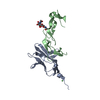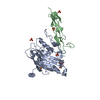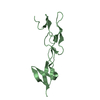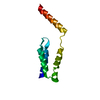+ Open data
Open data
- Basic information
Basic information
| Entry | Database: PDB / ID: 4fhq | ||||||
|---|---|---|---|---|---|---|---|
| Title | Crystal Structure of HVEM | ||||||
 Components Components | Tumor necrosis factor receptor superfamily member 14 | ||||||
 Keywords Keywords |  IMMUNE SYSTEM / CYSTEINE RICH DOMAIN / TNF RECEPTOR / IMMUNE SYSTEM / CYSTEINE RICH DOMAIN / TNF RECEPTOR /  Structural Genomics / PSI-Biology / Structural Genomics / PSI-Biology /  Protein Structure Initiative / Atoms-to-Animals: The Immune Function Network / IFN / Protein Structure Initiative / Atoms-to-Animals: The Immune Function Network / IFN /  TNFRSF / Cysteine Rich Domains / Receptor / TNF14 / TNFRSF / Cysteine Rich Domains / Receptor / TNF14 /  BTLA / BTLA /  CD160 / gD of HSV / CD160 / gD of HSV /  Membrane / New York Structural Genomics Research Consortium (NYSGRC) Membrane / New York Structural Genomics Research Consortium (NYSGRC) | ||||||
| Function / homology |  Function and homology information Function and homology informationnegative regulation of adaptive immune memory response / negative regulation of alpha-beta T cell proliferation /  tumor necrosis factor receptor activity / positive regulation of cytokine production involved in immune response / TNFs bind their physiological receptors / Costimulation by the CD28 family / tumor necrosis factor receptor activity / positive regulation of cytokine production involved in immune response / TNFs bind their physiological receptors / Costimulation by the CD28 family /  cytokine binding / positive regulation of T cell migration / T cell costimulation / positive regulation of peptidyl-tyrosine phosphorylation ...negative regulation of adaptive immune memory response / negative regulation of alpha-beta T cell proliferation / cytokine binding / positive regulation of T cell migration / T cell costimulation / positive regulation of peptidyl-tyrosine phosphorylation ...negative regulation of adaptive immune memory response / negative regulation of alpha-beta T cell proliferation /  tumor necrosis factor receptor activity / positive regulation of cytokine production involved in immune response / TNFs bind their physiological receptors / Costimulation by the CD28 family / tumor necrosis factor receptor activity / positive regulation of cytokine production involved in immune response / TNFs bind their physiological receptors / Costimulation by the CD28 family /  cytokine binding / positive regulation of T cell migration / T cell costimulation / positive regulation of peptidyl-tyrosine phosphorylation / virus receptor activity / cytokine binding / positive regulation of T cell migration / T cell costimulation / positive regulation of peptidyl-tyrosine phosphorylation / virus receptor activity /  adaptive immune response / defense response to Gram-negative bacterium / cell surface receptor signaling pathway / defense response to Gram-positive bacterium / adaptive immune response / defense response to Gram-negative bacterium / cell surface receptor signaling pathway / defense response to Gram-positive bacterium /  immune response / external side of plasma membrane / immune response / external side of plasma membrane /  innate immune response / innate immune response /  ubiquitin protein ligase binding / ubiquitin protein ligase binding /  plasma membrane plasma membraneSimilarity search - Function | ||||||
| Biological species |   Homo sapiens (human) Homo sapiens (human) | ||||||
| Method |  X-RAY DIFFRACTION / X-RAY DIFFRACTION /  SYNCHROTRON / SYNCHROTRON /  MOLECULAR REPLACEMENT / Resolution: 2.251 Å MOLECULAR REPLACEMENT / Resolution: 2.251 Å | ||||||
 Authors Authors | Liu, W. / Zhan, C. / Patskovsky, Y. / Bhosle, R.C. / Nathenson, S.G. / Almo, S.C. / Atoms-to-Animals: The Immune Function Network (IFN) / New York Structural Genomics Research Consortium (NYSGRC) | ||||||
 Citation Citation |  Journal: Mol Biotechnol / Year: 2015 Journal: Mol Biotechnol / Year: 2015Title: Increased Heterologous Protein Expression in Drosophila S2 Cells for Massive Production of Immune Ligands/Receptors and Structural Analysis of Human HVEM. Authors: Liu, W. / Vigdorovich, V. / Zhan, C. / Patskovsky, Y. / Bonanno, J.B. / Nathenson, S.G. / Almo, S.C. | ||||||
| History |
|
- Structure visualization
Structure visualization
| Structure viewer | Molecule:  Molmil Molmil Jmol/JSmol Jmol/JSmol |
|---|
- Downloads & links
Downloads & links
- Download
Download
| PDBx/mmCIF format |  4fhq.cif.gz 4fhq.cif.gz | 51.9 KB | Display |  PDBx/mmCIF format PDBx/mmCIF format |
|---|---|---|---|---|
| PDB format |  pdb4fhq.ent.gz pdb4fhq.ent.gz | 37.2 KB | Display |  PDB format PDB format |
| PDBx/mmJSON format |  4fhq.json.gz 4fhq.json.gz | Tree view |  PDBx/mmJSON format PDBx/mmJSON format | |
| Others |  Other downloads Other downloads |
-Validation report
| Arichive directory |  https://data.pdbj.org/pub/pdb/validation_reports/fh/4fhq https://data.pdbj.org/pub/pdb/validation_reports/fh/4fhq ftp://data.pdbj.org/pub/pdb/validation_reports/fh/4fhq ftp://data.pdbj.org/pub/pdb/validation_reports/fh/4fhq | HTTPS FTP |
|---|
-Related structure data
| Related structure data |  2aw2S S: Starting model for refinement |
|---|---|
| Similar structure data | |
| Other databases |
- Links
Links
- Assembly
Assembly
| Deposited unit | 
| ||||||||
|---|---|---|---|---|---|---|---|---|---|
| 1 |
| ||||||||
| Unit cell |
| ||||||||
| Details | AUTHOR DETERMINED BIOLOGICAL UNIT: NOT DETERMINED |
- Components
Components
| #1: Protein | Mass: 14332.176 Da / Num. of mol.: 1 / Fragment: extracellular domain residues 39-162 Source method: isolated from a genetically manipulated source Source: (gene. exp.)   Homo sapiens (human) / Gene: HVEA, HVEM, TNFRSF14, UNQ329/PRO509 / Plasmid: pMT-Bip-His / Cell (production host): Schneider 2 / Production host: Homo sapiens (human) / Gene: HVEA, HVEM, TNFRSF14, UNQ329/PRO509 / Plasmid: pMT-Bip-His / Cell (production host): Schneider 2 / Production host:   Drosophila melanogaster (fruit fly) / References: UniProt: Q92956 Drosophila melanogaster (fruit fly) / References: UniProt: Q92956 |
|---|---|
| #2: Water | ChemComp-HOH /  Water Water |
-Experimental details
-Experiment
| Experiment | Method:  X-RAY DIFFRACTION / Number of used crystals: 1 X-RAY DIFFRACTION / Number of used crystals: 1 |
|---|
- Sample preparation
Sample preparation
| Crystal | Density Matthews: 3 Å3/Da / Density % sol: 58.99 % |
|---|---|
Crystal grow | Temperature: 294 K / Method: vapor diffusion, sitting drop / pH: 8.5 Details: 0.2 M SODIUM ACETATE TRIHYDRATE, PH 8.5, TRIS-HCL, 30% W/V PEG4000, VAPOR DIFFUSION, SITTING DROP, temperature 294.0K |
-Data collection
| Diffraction | Mean temperature: 100 K |
|---|---|
| Diffraction source | Source:  SYNCHROTRON / Site: SYNCHROTRON / Site:  NSLS NSLS  / Beamline: X29A / Wavelength: 1.075 / Wavelength: 1.075 Å / Beamline: X29A / Wavelength: 1.075 / Wavelength: 1.075 Å |
| Detector | Type: ADSC QUANTUM 315 / Detector: CCD / Date: Mar 15, 2012 / Details: MIRRORS |
| Radiation | Protocol: SINGLE WAVELENGTH / Monochromatic (M) / Laue (L): M / Scattering type: x-ray |
| Radiation wavelength | Wavelength : 1.075 Å / Relative weight: 1 : 1.075 Å / Relative weight: 1 |
| Reflection | Resolution: 2.25→50 Å / Num. obs: 8551 / % possible obs: 99.3 % / Redundancy: 7.6 % / Biso Wilson estimate: 54.17 Å2 / Rmerge(I) obs: 0.104 / Rsym value: 0.09 / Net I/σ(I): 16.68 |
| Reflection shell | Resolution: 2.25→2.29 Å / Redundancy: 6.4 % / Mean I/σ(I) obs: 1.062 / % possible all: 94.7 |
- Processing
Processing
| Software |
| |||||||||||||||||||||||||||||||||||||||||||||||||||||||||||||||||||||||||||
|---|---|---|---|---|---|---|---|---|---|---|---|---|---|---|---|---|---|---|---|---|---|---|---|---|---|---|---|---|---|---|---|---|---|---|---|---|---|---|---|---|---|---|---|---|---|---|---|---|---|---|---|---|---|---|---|---|---|---|---|---|---|---|---|---|---|---|---|---|---|---|---|---|---|---|---|---|
| Refinement | Method to determine structure : :  MOLECULAR REPLACEMENT MOLECULAR REPLACEMENTStarting model: 2AW2 Resolution: 2.251→33.494 Å / SU ML: 0.47 / σ(F): 0 / Phase error: 38.13 / Stereochemistry target values: MLHL
| |||||||||||||||||||||||||||||||||||||||||||||||||||||||||||||||||||||||||||
| Solvent computation | Shrinkage radii: 0.6 Å / VDW probe radii: 0.9 Å / Solvent model: FLAT BULK SOLVENT MODEL / Bsol: 66.537 Å2 / ksol: 0.359 e/Å3 | |||||||||||||||||||||||||||||||||||||||||||||||||||||||||||||||||||||||||||
| Displacement parameters |
| |||||||||||||||||||||||||||||||||||||||||||||||||||||||||||||||||||||||||||
| Refinement step | Cycle: LAST / Resolution: 2.251→33.494 Å
| |||||||||||||||||||||||||||||||||||||||||||||||||||||||||||||||||||||||||||
| Refine LS restraints |
| |||||||||||||||||||||||||||||||||||||||||||||||||||||||||||||||||||||||||||
| LS refinement shell |
| |||||||||||||||||||||||||||||||||||||||||||||||||||||||||||||||||||||||||||
| Refinement TLS params. | Method: refined / Refine-ID: X-RAY DIFFRACTION
| |||||||||||||||||||||||||||||||||||||||||||||||||||||||||||||||||||||||||||
| Refinement TLS group |
|
 Movie
Movie Controller
Controller












 PDBj
PDBj

